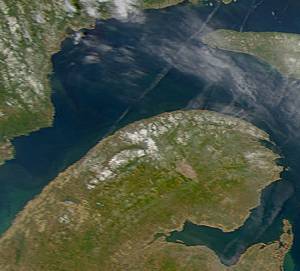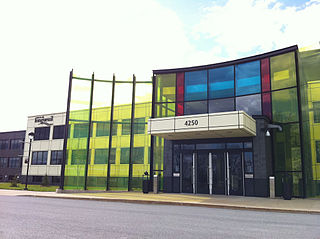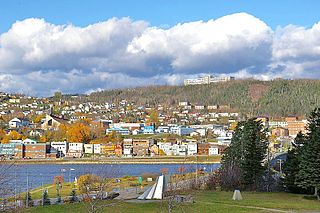
The Gulf of St. Lawrence fringes the shores of the provinces of Quebec, New Brunswick, Nova Scotia, Prince Edward Island, Newfoundland and Labrador, in Canada, plus the islands Saint-Pierre and Miquelon, possessions of France, in North America.

The Gaspé Peninsula, also known as Gaspesia, is a peninsula along the south shore of the St. Lawrence River that extends from the Matapedia Valley in Quebec, Canada, into the Gulf of St. Lawrence. It is separated from New Brunswick on its southern side by Chaleur Bay and the Restigouche River. The name Gaspé comes from the Mi'kmaq word gespe'g, meaning "end", referring to the end of the land.

Longueuil is a city in the province of Quebec, Canada. It is the seat of the Montérégie administrative region and the central city of the urban agglomeration of Longueuil. It sits on the south shore of the Saint Lawrence River directly across from Montreal. The population as of the Canada 2021 Census totalled 254,483, making it Montreal's second largest suburb, the fifth most populous city in Quebec and twentieth largest in Canada.

Canada has a large domestic and foreign tourism industry. The second largest country in the world, Canada's wide geographical variety is a significant tourist attractor. Much of the country's tourism is centred in the following regions: Toronto, Montreal, Quebec City, Vancouver/Whistler, Niagara Falls, Vancouver Island, Canadian Rockies, British Columbia's Okanagan Valley, Churchill, Manitoba and the National Capital Region of Ottawa-Gatineau. The large cities are known for their culture, diversity, as well as the many national parks and historic sites.

The culture of Quebec emerged over the last few hundred years, resulting predominantly from the shared history of the French-speaking North American majority in Quebec. Québécois culture, as a whole, constitutes all distinctive traits – spiritual, material, intellectual and affective – that characterize Québécois society. This term encompasses the arts, literature, institutions and traditions created by Québécois, as well as the collective beliefs, values and lifestyle of Québécois. It is a culture of the Western World.

Gaspé is a city at the tip of the Gaspé Peninsula in the Gaspésie–Îles-de-la-Madeleine region of eastern Quebec in Canada. Gaspé is about 650 km (400 mi) northeast of Quebec City and 350 km (220 mi) east of Rimouski. Gaspé has a total population of 15,063, as of the 2021 Canadian Census.

The Montreal Casino located in Montreal, Quebec, is the largest casino in Canada. Situated on Notre Dame Island, in Jean-Drapeau Park, it consists of two former Expo 67 pavilion buildings. The casino is open to the public seven days a week, operating morning until late night. It first opened on October 9, 1993.

Notre Dame Island is an artificial island in the Saint Lawrence River in Montreal, Quebec, Canada. It is immediately to the east of Saint Helen's Island and west of the Saint Lawrence Seaway and the city of Saint-Lambert on the south shore. Together with Saint Helen's Island, it makes up Parc Jean-Drapeau, which forms part of the Hochelaga Archipelago. To the southeast, the island is connected to the embankment separating the seaway and Lachine Rapids.

Loto-Québec is a crown corporation in the Canadian province of Quebec. Established in 1969, it oversees lottery and gaming in the province.
Autoroute 20 is a Quebec Autoroute, following the Saint Lawrence River through one of the more densely populated parts of Canada, with its central section forming the main route of the Trans-Canada Highway from the A-25 interchange to the A-85 interchange. At 585 km (363.5 mi), it is the longest Autoroute in Quebec. It is one of two main links between Montreal and Quebec City; the other is the A-40.

Route 138 is a major highway in the Canadian province of Quebec, following the entire north shore of the St. Lawrence River past Montreal to the temporary eastern terminus in Kegashka on the Gulf of St. Lawrence. The western terminus is in Elgin, at the border with New York State south-west of Montreal. Part of this highway is known as the Chemin du Roy, or King's Highway, which is one of the oldest highways in Canada.

The Montreal Fireworks Festival, is the largest fireworks competition in the world. It has been held yearly in La Ronde over the Dolphin Lake since 1985 and is named after its main sponsor, Loto-Québec. It hosts an estimated 3 million spectators each year, with approximately 6,000 fireworks set off during each show. Each summer, eight or nine pyrotechnical companies from different countries present a 30-minute-long pyromusical show, competing for the Gold, Silver and Bronze Jupiters or trophies.

The Casino du Lac-Leamy is a government-run casino located in Gatineau, Quebec, Canada.

The Casino de Charlevoix is located in Pointe-au-Pic, now part of La Malbaie, about 150 kilometres (93 mi) east of Quebec City. The historic Manoir Richelieu hotel is located right next to the casino. Charlevoix is a very popular tourist destination because of its location, next to the Saint Lawrence River and the Laurentian Mountains.

Jean Drapeau Park is the third-largest park in Montreal, Quebec, Canada. It comprises two islands, Saint Helen's Island and the artificial island Notre Dame Island, situated off the shore of Old Montreal in the Saint Lawrence River.

Montreal is the largest city in the province of Quebec, the second-largest in Canada, and the ninth-largest in North America. It was founded in 1642 as Ville-Marie, or "City of Mary", and is now named after Mount Royal, the triple-peaked mountain around which the early settlement was built. The city is centred on the Island of Montreal and a few, much smaller, peripheral islands, the largest of which is Île Bizard. The city is 196 km (122 mi) east of the national capital, Ottawa, and 258 km (160 mi) southwest of the provincial capital, Quebec City.

The Société des casinos du Québec is a subsidiary of Loto-Québec, a government of Québec corporation. The Société des casinos du Québec oversees all four government-run casinos in the province of Québec: the Casino de Montréal, the Casino du Lac-Leamy, the Casino de Mont-Tremblant, and the Casino de Charlevoix.
Matane is a former provincial electoral district in the Bas-Saint-Laurent and Gaspésie–Îles-de-la-Madeleine regions of Quebec, Canada, that elected members to the National Assembly of Quebec.

Sainte-Anne-des-Monts, is a city in La-Haute-Gaspésie Regional County Municipality, Gaspésie–Îles-de-la-Madeleine region, Quebec province, in Canada.
Gambling in Quebec includes Casino gambling in most crowded cities of the region, Lottery, Société des casinos du Québec and Sports betting. Games of chance have existed during the prohibition era but became legal in Quebec only in 1985 when gambling was made legal in the country. Unlike most Canadian provinces where the minimum age for gambling is nineteen, in Quebec, along with Alberta and Manitoba, the minimum age is eighteen.































